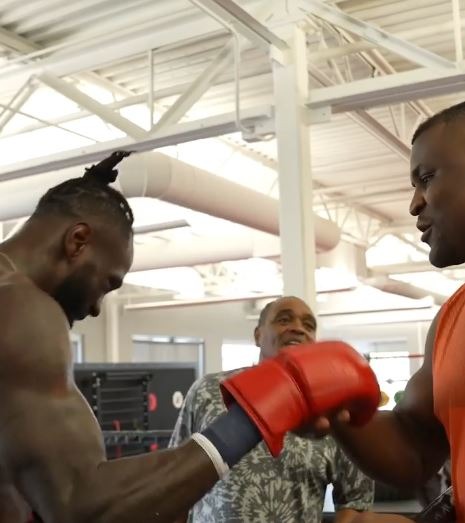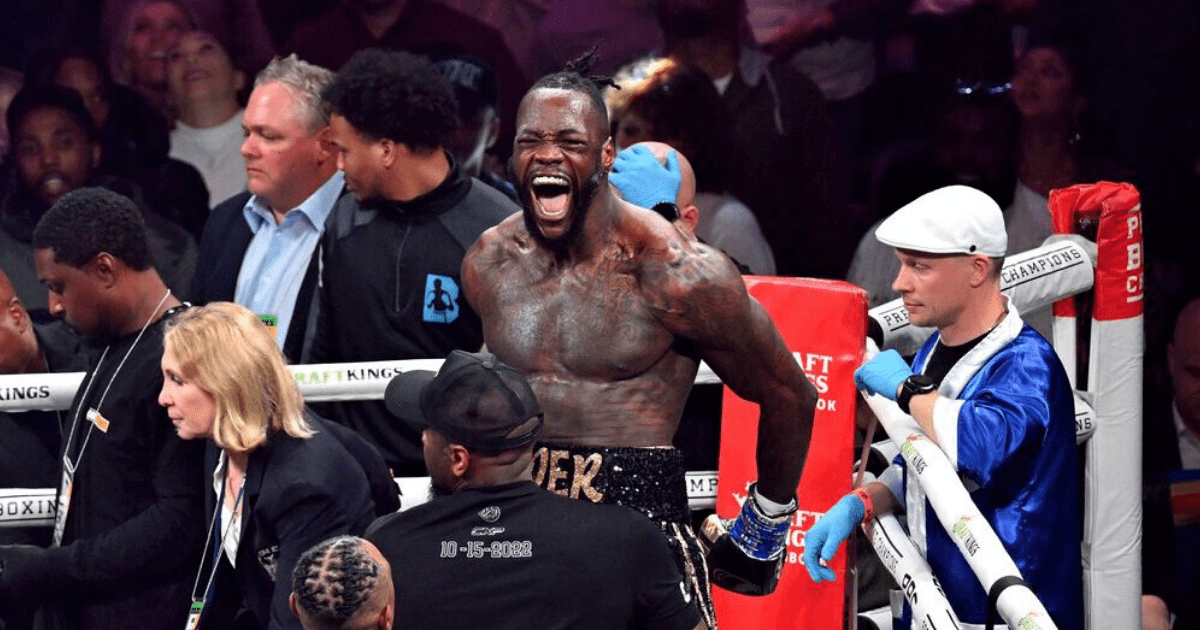FRANCIS NGANNOU has sent a chilling warning Deontay Wilder’s way after being called out by the boxer.
Former WBC heavyweight champion Wilder recently challenged the free agent to back-to-back fights inside the boxing ring and MMA cage.
Deontay Wilder recently challenged Francis Ngannou to a two-fight series
Former UFC heavyweight champion Ngannou has accepted the call-out

Ngannou and Wilder met at the UFC Performance Institute last year
The challenge came a matter of weeks after former UFC heavyweight champion Ngannou became a free man after failing to agree a new deal with the promotion.
And Cameroonian clubber Ngannou is happy to throw down with his fellow knockout artist, tweeting: “Welcome to the free world Bronze Bomber.
“I hope you are a man of your word. See you soon.”
He added: “I said only boxing so he can keep his limbs.
“Like I said we will see if he’s a man of his word.”
Wilder’s immediate future is currently up in the air as he’s reportedly fielding offers after being left disappointed with the potential purse for a clash with Andy Ruiz Jr.
The American hasn’t left Al Haymon’s PBC stable but insists he’s an “open agent”.
He told 78SPORTSTV: “I have no problem with PBC.
CASINO SPECIAL – BEST ONLINE CASINOS FOR 2023
“We’re still thriving, we’re strong, and I think PBC still has some of the best fighters out there.
“I don’t have nothing against PBC, we’re still working together as far as I know of.
“Me and Al Haymon still communicate, ain’t no bad blood against none of us.
“I’m still part of PBC, still looking to do fights on PBC.
“I’m just an open agent, I’m an open fighter. I want to fight on all types of platforms. I’m willing to work with anyone in the business.”
Wilder hasn’t fought since his brutal first-round knockout of Robert Helenius last October.
Free agent Ngannou, meanwhile, was last in action last January in his first and final defence of the UFC heavyweight crown against Ciryl Gane.
Frequently Asked Questions
How long does it take you to learn boxing
Boxing can be learned in 3 months. This includes learning the basics like footwork, balance, and stance. Boxing isn’t just about throwing punches. You need to learn how you can block and dodge attacks.
How can I improve my punching form?
Punching form is one of the most important parts of boxing. A good punch technique is essential if you are to become a better fighter. Here are some tips for improving your punching ability.
- Keep your head high. Your head should always be up while throwing punches.
- Punch from the shoulder. You should aim your punch at the shoulder rather than the chin.
- Concentrate on your feet. When you punch, don’t move your feet.
- Throw short, quick punches. Longer punches can tire you faster.
- Don’t forget about defense! Remember to stop incoming punches.
- Use your elbows. You can defend yourself by using your elbows.
- You can learn to use your legs. Your legs can save you from getting knocked over if you know how to use them properly.
- Every day, practice. Even if you feel tired, continue training. It takes practice to become proficient at anything.
- Have fun Enjoy what’s going on.
- Breathe. Correct breathing will help you feel stronger and more energetic.
- Relax. Don’t worry so much about making mistakes. Just focus on learning new things.
- Be patient. Boxing takes practice. It takes time to perfect your skills.
- Never stop improving. There will always be improvement.
- Listen to music. Listening to music can help you relax during training.
- You can watch videos of professional boxers. You may be inspired to work harder by watching them compete.
- Read books. Reading books can help you better understand boxing techniques.
- It is important to take breaks. Sometimes it’s helpful to take a break when you are boxing. Play soccer or basketball outside.
- Find a coach. Having a coach who knows boxing well can help you improve faster.
- Push-ups: Push-ups help build strength and endurance.
What are the health benefits of boxing
There are many benefits to boxing. For one, boxing can help build strong bones and muscles. Boxing can improve your coordination and reflexes. It also strengthens the heart and lungs. The best thing about boxing is that it doesn’t require any special equipment. You can use anything you have lying around the house.
What are the various types of boxing gloves available?
There are three types: mitts (fingerless mitts), full-fingerered gloves, and mitts (fingerless mitts). The padding around the knuckles of mitten gloves is called padding. Fingerless mitts don’t have any padding around your knuckles but still cover your fingers. Full-fingered gloves have padding around the entire hand.
Mittens are useful for striking the fist or punching. For striking or punching with the index finger’s knuckle, mitt gloves can be used. Boxing gloves that are full-fingered can be used to punch with your whole fist.
What is the difference between left hook and right cross?
A left hook is thrown at the side of the body and a right crossover is thrown at the front.
The opponent is facing the back of the left hook. The elbow is bent 90 degrees and the wrist is turned 45 degrees toward the opponent.
A right cross is thrown with the palm facing the opponent’s face and the elbow straight. The opponent is facing the wrist.
What are the 7 punches to boxing?
These seven punches are: jab cross, hook hook, uppercut straight right, left hook and body shot. These punches will be used to attack the opponent’s head, body and legs.
How long does learning to box take?
Boxing is the oldest known martial art. China is where the first known boxing match took place in 2200 BC. Boxing has been practiced for thousands of years. Boxing is still a popular sport among celebrities and athletes. However, it takes about 10 months to become proficient at boxing.
Because boxing involves so many movements, it is slow to learn. Each movement requires specific muscles in order to be effective. This is why it takes time for these muscles to grow.
But once you’ve learned how to move your body, you can start practicing any type of boxing technique. And over time, you’ll become more skilled at each technique.
Statistics
- It is just like normal sparring with a partner, but you want to throw punches at 75% of your normal speed. (wikihow.com)
- You want to be running at roughly 75-80% of your top speed..5 mile slow, easy recovery jog at the end.[6]X Research source 2Mix in long runs, shadow boxing, and short sprints on non-interval days. (wikihow.com)
External Links
amazon.com
- Amazon.com : Ringside Diablo Wrestling Boxing Boots : Clothing, Shoes & Jewel
- Amazon.com : Sanabul Boxing Handwraps Elastic 180 inch Red : Sports & Outdoors
en.wikipedia.org
How To
How to box for exercise
How to box for exercise
You learn boxing to increase your physical fitness and self-confidence. Boxing is one of the most popular sports in the world. It involves strength, speed and agility.
It’s a great way for you to feel fit and healthy. You’ll enjoy it so much, you’ll want more.
There are many different types of boxing training programs available. Some require you to train at home while others are done in gyms or health clubs. Online courses are available that you can access anywhere in the world.
It is important to find a program that suits your needs and your lifestyle. The best programs focus on exercises that increase muscle mass, flexibility and cardiovascular endurance. They also promote overall well being.
It is important to consider whether you would prefer a beginner’s or an advanced course. Beginner’s programs usually teach basic techniques and drills such as shadowboxing, sparring, mitt work, and punching combinations. Advanced programs usually cover more complicated movements and offer more options.
Programs for beginners usually last eight weeks and cost less that $100. However, they do not offer guidance on nutrition, weight reduction, injury prevention, or any other aspects of boxing training.
Advanced programs can last up to six months, and usually cost about $300. They often include nutritional advice, stretching routines, warm-up exercises, and instruction on proper technique. In addition, some programs incorporate resistance training (such as lifting weights) and aerobic conditioning (such as running).

